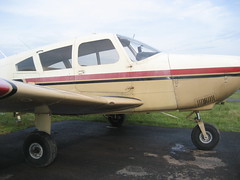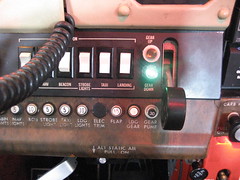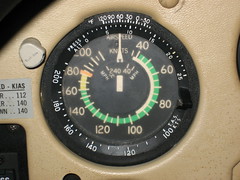 A morning flight is truly a treat. The air is smooth and the the sun presents a spectacular natural light show, transitioning from an amber glow to a yellow beam of light. An anticipatory smile grew on my face as I woke one fall morning, expecting an exciting day of flying ahead.
A morning flight is truly a treat. The air is smooth and the the sun presents a spectacular natural light show, transitioning from an amber glow to a yellow beam of light. An anticipatory smile grew on my face as I woke one fall morning, expecting an exciting day of flying ahead.
This seemed a perfect morning for a flight lesson, with a clear blue sky above and calm winds. My student John is a quick study, and I was expecting to complete training for his complex endorsement on this day.
After a preflight briefing and inspection of the aircraft we were under way. As we taxied to the runway I gazed skyward anticipating our flight. A grand view awaits only a few thousand feet above the colorful rolling hills of yellow and orange autumnal leaves.
In the cool dense air, our aircraft quickly accelerated and exhibited a grand performance in jumping from the runway when we pointed the plane skyward. Reaching a hundred feet off the ground my head was turning as if on a swivel, viewing the various colors as they appeared during our climb. The trees were as anticipated, beautiful and burnt orange. This is when I sensed something was not quite right.
The sound of the air and the view out the front window seemed unusual. After a quick survey of the controls in the cockpit, I noticed the culprit. The gear handle was in the down position. I then turned toward my student and asked, "do you think you may have missed something?".
I could see his smile replaced with a dumbfounded look. He quickly realized his mistake and reached for the gear handle. I then blocked his hand and reminded him we need to slow before gear retraction. We slowed and retracted the gear, much to his chagrin.
After John performed the required flight maneuvers flawlessly, we headed back to the airport for the post flight discussion. I mentioned to John I recently developed an after-takeoff checklist. I was using this new checklist when I fly and wanted to share it with him.
John was not unique in forgetting to raise the landing gear after takeoff. I observed many students forget the same tasks after they depart the airport and prior to completing the after-takeoff checklist. To alleviate this problem, I devised an after takeoff memory aid and acronym to help remind my students to properly configure the aircraft after takeoff.
The checklist is easy. Always remember we have the "GIFT" of flight once we are in the air. This should remind you to perform the GIFT checklist. It is important to realize this is not a substitute for the written checklist, just an extra reminder to confirm we have configured the aircraft properly. The acronym is simple and has prevented me from exceeding structural speed limits on all aircraft I fly, from single engine pistons to jets.
GIFT checklist:
 G - Gear Up. Most aircraft have a lower speed for retracting the landing gear (Vlo retraction) than for extending the landing gear (Vlo extension). The lower retraction speed is primarily due to the gear mechanism having to overcome both aerodynamic forces and gravitational forces while raising the gear. Some landing gear are designed with gear doors aerodynamically assisting in gear extension. Unfortunately, this additional force must be overcome when raising the gear. It is important to read your airplane flight manual to determine the proper gear retraction speed so as to not over stress the gear mechanism.
G - Gear Up. Most aircraft have a lower speed for retracting the landing gear (Vlo retraction) than for extending the landing gear (Vlo extension). The lower retraction speed is primarily due to the gear mechanism having to overcome both aerodynamic forces and gravitational forces while raising the gear. Some landing gear are designed with gear doors aerodynamically assisting in gear extension. Unfortunately, this additional force must be overcome when raising the gear. It is important to read your airplane flight manual to determine the proper gear retraction speed so as to not over stress the gear mechanism.
 I - Indicated airspeed. Check your airspeed for best performance and to comply with speed restrictions. To increase visibility, provide engine cooling, and obtain a higher ground speed; accelerate to either the best rate of climb (Vy) or a the recommend departure climb airspeed. You also must comply with airspeed assignments given by air traffic control or limits as specified in the regulations. In the past, speed restrictions primarily applied only to pilots flying jets and turbo props. With the advent of faster piston aircraft, we might find ourselves flying a rental aircraft capable of exceeding 200 knots. Within Class C and D airspace and within 4 nautical miles and up to 2,500 feet of the surface, the maximum speed is 200 knots indicated.
I - Indicated airspeed. Check your airspeed for best performance and to comply with speed restrictions. To increase visibility, provide engine cooling, and obtain a higher ground speed; accelerate to either the best rate of climb (Vy) or a the recommend departure climb airspeed. You also must comply with airspeed assignments given by air traffic control or limits as specified in the regulations. In the past, speed restrictions primarily applied only to pilots flying jets and turbo props. With the advent of faster piston aircraft, we might find ourselves flying a rental aircraft capable of exceeding 200 knots. Within Class C and D airspace and within 4 nautical miles and up to 2,500 feet of the surface, the maximum speed is 200 knots indicated.
 F - Flaps. Some airplanes require the use of flaps during every takeoff, and most planes are designed to use partial flaps for short and soft field takeoffs. Forgetting to raise the flaps before we begin accelerating the aircraft can cause structural failure to the flaps or the flap retraction/extension mechanism. This can lead to an expensive mechanical inspection and repair.
F - Flaps. Some airplanes require the use of flaps during every takeoff, and most planes are designed to use partial flaps for short and soft field takeoffs. Forgetting to raise the flaps before we begin accelerating the aircraft can cause structural failure to the flaps or the flap retraction/extension mechanism. This can lead to an expensive mechanical inspection and repair.
T - Transponder and Throttles. Most of us fly in airspace requiring the use of a transponder. At least once a month I hear a controller asking a pilot to check their transponder because they are not receiving their beacon code. Those of us flying in uncontrolled airspace beneath the Class B airspace must have our transponder "on" at all times. With increased security and many airplanes equipped with collision avoidance software, we need to verify our transponder is "on" or, more appropriately, in the ALT position. After the transponder is in the ALT position, set the throttles properly for climb. In a complex airplane, reduce the throttle first then reduce the propeller RPM. Many times the throttle reduction is overlooked after takeoff and can cause over-stressing of the aircraft engine.
I can attest to having forgotten the above items once or twice. I don't forget these items when using the GIFT of flight checklist. Whether I am flying a light single engine piston aircraft or flying as Captain for a commercial airline, I always use the GIFT checklist. You would be surprised the number of airline flight crews who have exceeded the airspeed limitations on both the gear and on the flaps, even after performing the after takeoff checklist. Performing the GIFT checklist after takeoff will alleviate these problems.
I encourage you to use this checklist next time you fly. Simply remember, after take off you have the GIFT of flight.
G -Gear Up.
I - Indicated airspeed.
F - Flaps Up.
T - Transponder on, Throttles set for climb.
For More Information:
FAR 61.31 - See Additional training required for operating complex airplanes
Recommended:

Comments on this entry are closed.
Good technical and interesting article that makes the safety issues of flying entertaining and interesting. I know a lot of pilots will learn from your “Gift” List.
I think you omit, few other things, like manifold pressure, RPM, attitude/altimeter/airspedd and CHT. I use something like
GMRFAT or G mister fat.
Gear, Manifold, RPM, Flaps, Airspeed,Temperature (CHT).
I hope you like it 😉